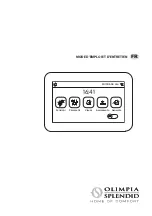
36
After accessing the "Language" function, you can
choose the system language (Italian, English or Span-
ish). Make your selection, then press “OK” to confirm.
Language
English
Spanish
Italian
OK
Cancel
8.7.
Selecting the system language (Language)
This function activates the WiFi signal that allows you to use the app to control the unit.
NOTES:
1.
The app is compatible with ANDROID and iOS systems.
2.
The unit can only be managed via a WiFi or hotspot 4G signal.
3.
The system is not compatible with routers that use WEP cryptography.
8.8.
Activating the WiFi (WiFi)
36
After accessing the "Language" function, you can
choose the system language (Italian, English or Span-
ish). Make your selection, then press “OK” to confirm.
Language
English
Spanish
Italian
OK
Cancel
8.7.
Selecting the system language (Language)
This function activates the WiFi signal that allows you to use the app to control the unit.
NOTES:
1.
The app is compatible with ANDROID and iOS systems.
2.
The unit can only be managed via a WiFi or hotspot 4G signal.
3.
The system is not compatible with routers that use WEP cryptography.
8.8.
Activating the WiFi (WiFi)
36
After accessing the "Language" function, you can
choose the system language (Italian, English or Span-
ish). Make your selection, then press “OK” to confirm.
Language
English
Spanish
Italian
OK
Cancel
8.7.
Selecting the system language (Language)
This function activates the WiFi signal that allows you to use the app to control the unit.
NOTES:
1.
The app is compatible with ANDROID and iOS systems.
2.
The unit can only be managed via a WiFi or hotspot 4G signal.
3.
The system is not compatible with routers that use WEP cryptography.
8.8.
Activating the WiFi (WiFi)
37
If error or alarm conditions arise during normal operation of the unit, faults will be indicated on the dis-
play by icons (
); it will also be possible to obtain more information about active errors by checking the
specific page in the "View" "Error" page menu (as specified in paragraph 6.3).
Possible errors (with relative codes) are as follows:
Label Error
Description
Code
Ambient sensor
indicates a malfunction of the external air sensor
F4
Defrost sensor
Indicates a malfunction of defrosting temperature sensor on the outdoor
unit
d6
Discharge sensor
Indicates a malfunction of the temperature sensor on compressor delivery
F7
Suction sensor
Indicates a malfunction of the temperature sensor on compressor intake
F5
Econ. in sens.
Indicates a malfunction of the temperature sensor at the economizer input
F2
Econ. out sens.
Indicates a malfunction of the temperature sensor at the economizer output
F6
Error fan
Indicates a malfunction a
ff
ecting the fan on the outdoor unit
EF
High pressure
Indicates abnormal pressure on the high pressure side of the cooling circuit
E1
Low pressure
Indicates abnormal pressure on the low pressure side of the cooling circuit
E3
Hi-discharge
Indicates an abnormal temperature on the compressor discharge
E4
Capacity DIP
Indicates a DIP SWITCH positioning error on the outdoor unit board
c5
ODU-IDU Com.
Indicates a serial communication error between the AP1 and AP2 cards on
the outdoor unit
e6
Drive main com
Indicates a serial communication error between the AP2 and AP4 cards on
the outdoor unit
P6
IDU Com.
Indicates a serial communication error between the AP1 cards and
fl
ush
panel (display)
E6
HI-pre. sens.
Indicates a fault on the high pressure transducer
Fc
Temp HELW
Indicates a fault on the temperature sensor at heat exchanger plate outlet
(water side)
F9
Temp AHLW
Indicates a fault on the temperature sensor located downstream of the
3-way valve if the installation includes an auxiliary electrical resistance or a
supplementary heat source
dH
Temp HEEW
Indicates a fault on the temperature sensor at heat exchanger plate inlet
(water side)
——
HI-pre. sens.
Indicates a fault on the temperature sensor located on the accessory DHW
storage tank
FE
T-remote room
indicates a malfunction of the ambient air sensor supplied with the unit
F3
HP-Water Switch
Indicates an alarm generated by the
fl
ow switch at the input to the outdoor
unit (water side)
Ec
Auxi. heater 1
Indicates a malfunction a
ff
ecting the auxiliary resistance 1 (KM1)
EH
Auxi. heater 2
Indicates a malfunction a
ff
ecting the auxiliary resistance 2 (KM2)
EH
Auxi. -WTH
Indicates a malfunction a
ff
ecting the resistance placed in the accessory
DHW storage tank (KM3)
eh
DC under vol.
Indicates an error caused by low voltage on the DC bus or an error caused
by a voltage drop
PL
DC over vol.
Indicates an error caused by high voltage on the DC bus
PH
AC curr. pro.
Indicates an abnormal value for AC current (AC protection)
PA
IPM defective
Indicates an operating fault on the IPM module (inverter power module)
H5
PFC defective
Indicates an operating fault on the PFC module (power correction module)
Hc
Start failure
Indicates a fault in the unit's start-up phase
Lc
Phase loss
Indicates a problem associated with the loss or unbalance of voltage phases
Ld
Driver Com.
Indicates a communication error with the unit's drivers
P6
Driver reset
Indicates a reset made on the unit's drivers
P0
Com. over-cur.
Indicates that an overcurrent on the compressor has been detected
P5
Overspeed
Indicates that an incorrect compressor speed has been detected
LF
Current sen.
Indicates an abnormal value for the current sensor
Pc
Desynchronize
Indicates that the compressor is out of sync
H7
9.
ALARM CODES
Summary of Contents for SHERPA MONOBLOC
Page 191: ......
Page 192: ...262617B...
















































